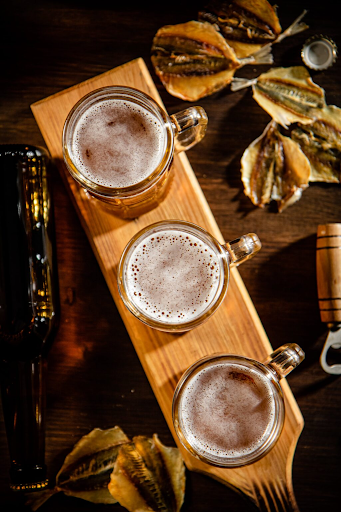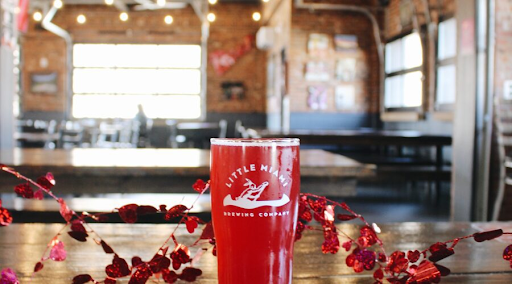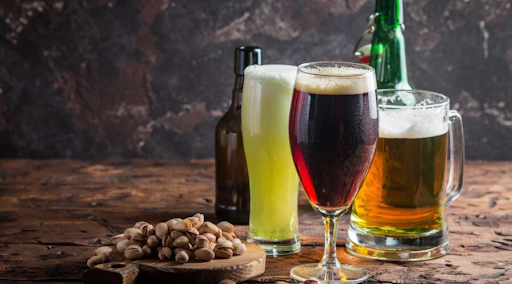Brewing Roots: Honoring the Ziegler Legacy in Cincinnati
Let’s take a trip back to when the smell of hops hung thicker than August humidity, and breweries weren’t just businesses—they were neighborhood anchors. The Ziegler family got it. Their brewery didn’t just make beer; it poured life into weddings, block parties, and everyday bonds that lasted generations.
Fast forward to today. Not much has changed. Sure, the horse-drawn wagons are gone (thankfully), but walk into Little Miami Brewing Company today and you’ll feel that same energy—the clink of glasses, the buzz of conversation, the sense that this pint is part of something bigger. Maybe it’s because we’re brewing in the historic Ziegler Building, or maybe it’s because Cincinnati’s beer DNA never really left. Either way, this legacy deserves a pour and a toast.
So grab a cold one and settle in as we dig into the history, pour out unexplored stories, and the reason why your local pint tastes like home.
Cincinnati’s Golden Age: When Beer Flowed Like the Ohio River
Imagine a Cincinnati where smokestacks didn’t just signal industry—they were beacons calling thirsty workers to bustling breweries. From the 1880s to Prohibition, Cincinnati was in its beer-soaked prime, and Ziegler Brewing was right in the thick of it.
Why Cincinnati? (Spoiler: It Was Basically Perfect)
Here’s why we became the beer capital before hashtags even existed:
The Water
- That limestone-filtered Ohio River water? It’s brewing gold. Even today, our brewmaster swears by it.
The Germans
- They didn’t just bring pretzel recipes—they brought brewing expertise and standards. Ever had a properly lagered beer? Thank them!
The Grit
- Ziegler and others didn’t just endure the 1800s—they thrived through cholera outbreaks, fires, and red tape to make a modern brewer cry.
Fun Fact: At its peak, Cincinnati produced more beer than St. Louis and Milwaukee combined. Let that sink in next time someone calls this a “Budweiser town.”
Ziegler’s Secret Sauce
While big names like Moerlein got the headlines, Ziegler Brewing quietly became the neighborhood favorite. That’s because they:
- Used local grains (farm-to-table before it was a buzzword)
- Hired half the block (real “help your neighbor” energy)
- Innovated under pressure (their “near beer” pre-Prohibition pivot? Genius.)
Where You Can Still Taste That Legacy
Cincinnati’s brewing history isn’t just in dusty books—it’s on tap:
- The original Ziegler building still stands proud in Over-the-Rhine
- Engaging events where we pour beers with stories
Want to go deeper? Check out the Genealogy & Local History of Cincinnati.
The Ziegler Brewing Co. Story

What’s the secret to a brewery lasting 68 years in the 1800s? (Hint: It wasn’t just about the beer.) In a time when breweries failed like bad fermentation, the Zieglers did these three things differently:
They Brewed for Their Neighborhood, Not the Masses
While bigger names chased regional fame, Charles Ziegler served the folks next door:
- Lagers that tasted like home (using yeast smuggled in steamer trunks)
- Affordable steins (because every worker deserved a good pour)
- Trust that ran deep (their delivery wagons were as reliable as church bells)
They Adapted Before They Had To
When temperance began brewing trouble in the 1890s, Ziegler:
- Launched a “Temperance Beer” (0.5% ABV)
- Opened a bottling plant for home consumption
- Donated to churches (smart strategy, not just goodwill)
Their Failure Taught Us Everything
Prohibition finally shut the business down in 1922. But what was lost was more than just a business:
- The human cost: Many local jobs vanished overnight
- The cultural loss: Block parties faded into memory
- The recipe graveyard: Their acclaimed “Winter Stock Ale” died with them
Little Miami’s Tribute to the Ziegler Legacy
“January 17, 1920: The Day Cincinnati’s Breweries Went ‘Underground’ (Literally)”
The Volstead Act didn’t just ban beer—it declared war on a way of life. For Ziegler and other brewers, survival meant playing a dangerous game. Well, Cincinnati’s brewers got creative to keep the beer flowing through the city’s veins.
The Greatest Legal Loopholes in Brewing History
The “Whoops, It Fermented” Excuse
Suddenly, every brewer had a “math problem”:
- “Oh no, our cereal beverage fermented into 3.2% beer!”
- “Must’ve been the yeast… or the Cincinnati water!”
The truth? They sold malt syrup with instructions that practically said, “Mix with water and leave in a warm place for 7 days. Definitely don’t add hops.”
Ice Cream Trucks & Other Sneaky Tricks
Some “diversions” were genius:
- Ziegler’s new “ice cream division” (with suspiciously foamy deliveries)
- Delivery boys? They knew every speakeasy address
- Pharmacies? Stocked “tonics” that definitely weren’t cough syrup
The Tunnels No One Talks About
Let’s just say… those underground passages between breweries weren’t for storing potatoes. Recent digs found:
- Piles of bottle caps in “abandoned” basements
- A 500 lb hop order labeled as “floral decorations”
Why This Still Matters?
That rebellious spirit never really left Cincinnati beer. At Little Miami Brewing, we honor it every day:
- Our taproom in the old Ziegler Building still whispers stories
- Our block parties are our way of saying, “Take that, temperance.”
Want to hear it all? Take a brewery tour of our taproom and ask about:
- The secret recipe that was found scratched into a beam
- The 1920s yeast strain our head brewer still keeps alive (“just in case”)
- The homebrew gear passed down from grandparents across the city
Cincinnati’s Living Beer Heritage
Prohibition ended in 1933—but try telling that to Cincinnati’s empty breweries.
The “noble experiment” left scars. By 1935, only 3 of the city’s 28 pre-Prohibition breweries were still standing. The Ziegler building? Reduced to a storage spot for tractor parts. But the soul? That lived on.
The Underground Keepers of the Flame
While big names folded, real magic happened in:
- Grandpas secretly kept Ziegler’s yeast strains alive in mason jars
- Backroom bars served “imported” beer with very local flavors
- Church festivals poured “lemonade” with a suspiciously spicy kick
1970s: The First Glimmers of Hope
When microbreweries were still a West Coast thing, Cincinnati was:
- Hosting secret homebrewing clubs (shhh, it was illegal until 1978)
- Passing down old-school brewing wisdom ‘the right way’ (i.e., the German way)
- Serving real lagers in defiance of mass-produced trends
Why This Isn’t Just Nostalgia?
Because every time we:
- Use a 100-year-old yeast strain
- Host a fundraiser in the same halls where brewery workers once rallied
- Brew beer breaks trends but honors roots
…we raise a glass to the stubborn folks who refused to let Cincinnati’s beer soul die.
Planning a Brewery Visit with a Side of History

While Americans chased IPAs and Portland hipsterdom in the 1990s, Cincinnati was quietly nursing a 150-year-old grudge. Our breweries were kings even before Prohibition wrecked everything.
The Rebel Brewers Who Started It All
This wasn’t a corporate “craft beer movement.” This was:
- Basement brewers using smuggled yeast
- Bartenders sneaking in local kegs under Big Beer’s radar
- Drinkers demanding proper lagers, even when no one else was
Why Little Miami Brewing Fits Right In
We didn’t just open a brewery—we joined a rebellion:
- Our taproom? Standing in the Ziegler legacy
- Our events? Basically, modern block parties with deeper roots.
- Our mission? Prove Cincinnati never lost its crown—we just set it down for a few decades.
Take a virtual tour of our beautiful brewery and taproom.
The Proof Is in the Pint Glass
Today, when you drink at one of Cincinnati’s best breweries, you’re tasting:
- German heritage in properly lagered beers
- Rebel creativity in rule-breaking brews
- Community grit in every pint poured for a cause
Here’s why Little Miami Brewing should be on your list at the top.
Raise a Glass: Your Invitation to Keep Cincinnati’s Beer Legacy Alive
Here’s the secret no one tells you—history isn’t just something you read. It’s in the glass you raise.
The Ziegler story doesn’t end with dusty ledgers or museum exhibits. It lives on every time someone cracks open a locally brewed lager at a neighborhood block party or when a homebrewer digs up their great-grandfather’s recipe.
Now, it’s your turn to be part of it.
Got old brewery photos, stories, or recipes? We would love to hear from you.
Don’t just read Cincinnati’s beer history—drink it. Live it. Visit us today!

